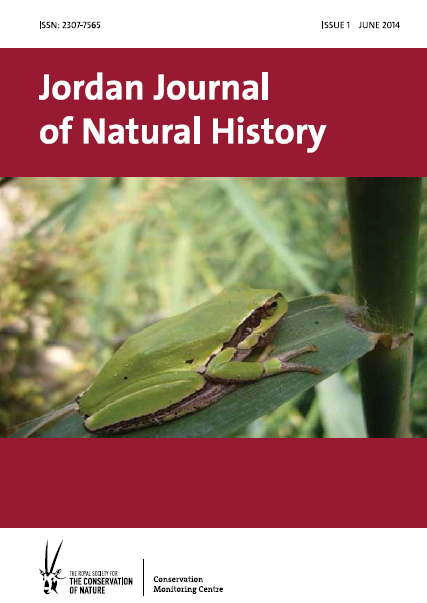The paleoclimate of Jordan during the Pleistocene as a possible indicator for future climate change: an overview
Author Name
Abdulkader M. Abed
Several fresh to brackish water paleolakes were formed and sustained in Jordan during the warmer and wetter periods of the Pleistocene: including Umari Lake during the Marine Isotope Stage MIS 9 at 330 Ka (thousand/year), Mudawwara and Samra Lakes during the MIS 5 130-70 Ka, Lisan and Jafr Lakes 30-33 and 25-27 Ka respectively, and the Burqu’ Lake during the Holocene Optimum 9-6 Ka. Studies on the mineralogy of the lake sediments and of their fossil remains
all indicate that the water of the lakes was initially fresh but became more brackish at times depending on the climate change. Most of these lakes were more than 1000 km2 in area and from 10 to few hundred metres deep, with possible water temperature of between 15-20°C. Present-day climate cannot account for the presence of such lakes in the arid to semi arid area of Jordan. Therefore more intense and wetter Mediterranean cyclones in winter coupled with Arabian monsoon or even Arabian-Indian monsoon in summer would have affected major parts of Jordan up to latitude 31° 32´ during the warmer periods of the Pleistocene and brought more rain to establish and sustain such lakes. However, summer monsoon rains currently postulated for Jordan and adjacent areas remain controversial and are not fully accepted by other workers in this area of research. Consequently, more detail work on the paleoclimate of the Jordan is needed
Vegetation Community Analysis in Mujib Biosphere Reserve, Jordan
Author Name
Dawud Al-Eisawi
Field surveys of the plants and vegetation of the Mujib Biosphere Reserve in Jordan were carried out between 2005 and 2007. The study covered all areas of the reserve as defined by latitudes 7425000 W to 757000 E and longitudes 3501000 N to 3474500 S (total reserve area = 220 km2). Plants and their vegetation were sampled both by area plots and line transects. Transect routes were directed from east to west across the reserve and defined as sectors (1-7). These generally included a range of altitudes from 900m down to -400m
along the border with the Dead Sea. Various parameters were recorded during the study including the site name, its location (GPS coordinates), principle plant species present, and their life forms together with associated species and soil conditions. Various species were collected, photographed, and later deposited at the Herbarium of the Department of Biological Sciences, Faculty of Science, University of Jordan. From the various plant associations observed, three biogeographic regions were recognised, namely Mediterranean, Irano-Turanian and Tropical (Sudanian). In addition, five plant communities
were identified and allocated to named classes as Artemisia herba-alba; Retama raetam – Salsola vermiculata; Zygophyllum dumosum; hydric vegetation and tropical vegetation. Differences within classes were grouped as sub-classes. The total number of plant species recorded during the survey was 408 which included several new and rare species to the flora of Jordan. An illustrated map showing the distribution of vegetation areas across the reserve is presented
Contribution to the Hawk Moths (Sphingidae: Lepidoptera) of Jordan
Author Name
Ahmad Katbeh-Bader
Hawk moths (Sphingidae) have been collected from different parts of Jordan by light traps from 2007 to 2014. Unidentified specimens preserved at the Unversity of Jordan Insects Museum were examined. The following nine species are recorded from 38 localities across Jordan: Acherontia atropos (Linnaeus, 1758), Agrius convolvuli (Linnaeus, 1758), Marumba quercus (Denus & Schiffermuller, 1775), Daphnis nerii (Linnaeus, 1758), Macroglossum stellatarum (Linnaeus, 1758), Hyles euphorbiae conspicua (Rothschild & Jordan, 1903), Hyles
livornica (Esper, 1779), Hippotion celerio (Linnaeus, 1758) and Theretra alecto cretica (Boisduval, 1827).
Notes on the current and past freshwater snail fauna of Jordan
Author Name
Zuhair Amr, Hussain Nasarat & Eike Neubert
Past and current distribution of the freshwater snils of Jordan is given. The freshwater snail fauna of Jordan belongs to two subclasses of the class Gastropoda (Prosobranchia and Pulmonata). Prosobranchians includes seven families (Bithyniidae, Cochliopidae, Neritidae, Hydrobiidae, Melanopsidae, Neritidae, Thiaridae and Valvatidae) with ten genera (Bithynia, Globuliana, Heleobia, Melanoides, Melanopsis, Plotia, Pseudamnicola, Pyrgophorus, Theodoxus and Valvata) representing 16 species. Pulmonates are represented by three families (Lymnaeidae, Physidae and Planorbidae) within six genera (Bulinus, Haitia, Galba, Gyraulus, Lymnaea and Planorbis) and six species.
Distribution and Cytogenetics of Amphibians from the Occupied Palestinian territories (West Bank of Jordan)
Author Name
Ibrahim N. A. Salman, Michael Salsaa, & Mazin B. Qumsiyeh
The distribution of four species of amphibians (Bufotes variabilis, Pelophylax bedriagae, Hyla savignyi / H. felixarabica, and Pelobates syriacus) are given in the occupied Palestinian territories of the West Bank are recorded. Karyotypic data on Bufotes variabilis (2n=22) and Pelophylax bedriagae (2n=26) are reported
Satellite Tracking of the Lappet-faced Vulture Torgos tracheliotos in Saudi Arabia
Author Name
Mohammed Y. Shobrak
Two Lappet-faced Vultures (Torgos tracheliotos), were fitted in early 1995 with Satellite transmitters at the Mahazat as-Sayd protected area located in Central west Saudi Arabia in order to track their movements. After release, the vultures left the reserve for approximately seven months, both returning in the autumn. Both birds visited areas to north-east or north of the reserve, though one tended to range over greater distances. The movements of these two birds supported observations of seasonal changes in the abundance of Lappet-faced Vultures in the Mahazat as-Sayd protected areas, and also indicated that some birds engage in short-distance migration within Saudi Arabia. In addition, the movements of these two birds suggest that there is a possibility of contact between other Lappet-faced Vultures populations within Saudi Arabia and those in neighbouring countries. This suggests that a single meta-population could range over the Arabian Peninsula
The numbers of breeding and migrant birds at the Royal Society for the Conservation of Nature (RSCN) Azraq Wetland Reserve 2004 to 2011
Author Name
Peter M. Ellis
The Azraq Oasis and Qa al Azraq Ramsar site were one of the most important and impressive wetlands in the Middle East, providing an invaluable resource to local people and wildlife. However, in 1993, the abstraction of water from the Azraq aquifer resulted in the oasis completely dying up. In 1994, the Royal Society for the Conservation of Nature (RSCN) secured a supply of water to establish the Azraq Wetland Reserve. RSCN has successfully restored part of the Azraq Oasis. This paper presents the results of a study to monitor the numbers of breeding and migrant birds using the Azraq Wetland
reserve between 1999 and 2011. With a few exceptions, most species of breeding and migrant birds appear to have declined in numbers since 2004, probably as a result of the very dry conditions.
Monitoring, threats and conservation of hibernating bats roosts in Lebanon
Author Name
Mounir R. Abi-Said
In this study up to 41 sites known to contain hibernating bats were surveyed during the winter of 2012-2013. There was a noted increase in the Egyptian fruit bat, Rousettus aegyptiacus, population in Berqayel cave. This increase was probably due to the effectiveness of the awareness program that was conducted in Berqayel after the 2010 disturbance; where thousands of R.aegyptiacus were shot or suffocated by fire in the cave and the destruction of the cave entrance. New roosting sites were reported for different species. However, there was a decrease in Rhinolophus blassii and Miniopterus schreibersii populations, mainly due to human disturbance. Proposed conservation measures including follow-up monitoring of bats, and broader public awareness programs are highly recommended for more effective bat conservation.
The use of multi-criteria evaluation and expert knowledge in developing protected area zoning plans in Jordan
Author Name
Natalia M. Boulad
Protected areas (PAs) in Jordan are managed through scientifically based management plans (MPs). Zoning plans are created as supporting plans to MPs when different management procedures need to be applied in different parts of a PA. A GIS-based zoning plan model was developed using spatial multi-criteria evaluation technique (MCE). The model was created to provide a systematic repeatable approach to evaluate the conservation values and human threat, thus facilitating the decision making process for PA’s zoning in Dibeen forest in the northwest of Jordan. Cartographic modeling was used to combine datasets with different attributes by reclassifying them according to a common comparison scale, and finally adding them according to their assigned relative weights. The resulting weighted summation rasters identified areas with high conservation values-high human threat, high conservation values- low threat, and low conservation values- high human threat. The PA was divided accordingly into three management zones: an intensive use zone where tourism and other human activities are allowed but restricted to a small area, a semi-intensive use zone where educational activities are allowed, and finally a wilderness zone that includes the most ecologically important and representative habitats of the PA where all human activities are prohibited except wildlife research and monitoring. The zoning plan model developed for Dibeen Forest Reserve can also be applied to other PAs in Jordan and within the region taking into consideration that the evaluation criteria and weights can be modified depending on the characteristics of each PA and the data available.




